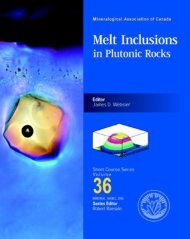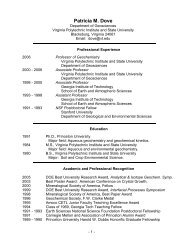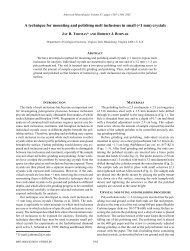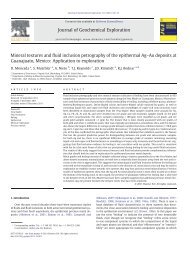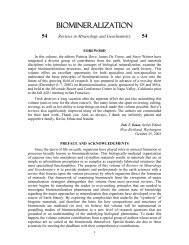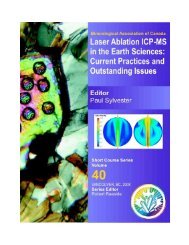212 Young & Henriksenbiomineralization systems, hence it is reasonable to infer that the nucleation controlmechanism should be similar for all coccolith cases. For the V/R alternation <strong>of</strong> nuclei inthe heterococcolith rim, template control has been a tempting theory, particularly sincethe nucleation is confined to single, well-defined belts with the organic base-plate scaleavailable as a substrate for the nucleation template (Young et al. 1992; Marsh et al.1999). However, with holococcoliths and heterococcolith central area structures,crystallographic orientation control is equally precise, but nucleation is much moredispersed. Hence, a self-organizing system seems more likely than nucleation on a predesignedtemplate. Given this insight, in vitro experiments on the effects <strong>of</strong> coccolithassociatedmacromolecules become more important.Crystal growth regulation<strong>The</strong> styles <strong>of</strong> growth regulation seen in heterococcoliths, holococcoliths andnannoliths are rather variable. Heterococcolith rim crystals show selected growth inparticular directions, complex development <strong>of</strong> rhombic faces to fill non-rhombohedralspace and blocked growth to produce non-crystalline surfaces. Heterococcolith centralarea growth tends to show only rhombic face development, but with elaborateinterlocking crystal growth. In holococcoliths, growth is confined to rhombohedra butblocked at a finite size. So there is great variation in the details <strong>of</strong> precise regulationwithin a basic motif.Genomic approaches<strong>The</strong> parallel approaches <strong>of</strong> biochemical and morphological research have been appliedrather extensively to coccolithophore calcification and are arguably at a relatively maturestate <strong>of</strong> knowledge, although new insights are emerging from atomic force microscopy(Henriksen et al. in press a,b) and from study <strong>of</strong> polysaccharide effects in mutant strains(Marsh and Dickinson 1997; Marsh 2000). Probably the most promising approach for thefuture will be genomic research aimed at identifying the suite <strong>of</strong> genes responsible forbiomineralization and their functions. In this general field, the coccolithophores mayprove to be ideal test cases for a number <strong>of</strong> reasons. First, as protests, they have relativelysmall genomes. Second, they are readily grown in culture and can be experimented uponwithout ethical dilemmas. Third, the considerable interest in coccolithophores from otherperspectives means that genomic projects on them are already underway. Finally, the factthat different biomineralization modes occur within two phases <strong>of</strong> a single organismprovides a natural experimental system for comparing the biomineralization-related genesexpressed in the two life stages.ACKNOWLEDGMENTSWe are grateful to many colleagues for scientific collaboration over an extendedperiod, especially Paul Bown, Markus Geisen, Steven Mann, Ian Probert, Blair Steel,Susan Stipp, Mary Marsh and Peter Westbroek. Research funding has been provided bythe UK Natural Environment Research Council, <strong>The</strong> European Union (through theCODENET FP4 TMR network project) and the Danish Research Council.REFERENCESAlcober J, Jordan RW (1997) An interesting association between Neosphaera coccolithomorpha andCeratolithus cristatus (Haptophyta). Eur J Phycol 32:91-93Billard C (1994) Life cycles. In: <strong>The</strong> Haptophyte Algae. Green JC, Leadbeater BSC (eds) Clarendon Press,Oxford, p 167-186Billard C, Inouye I (in press) What's new in coccolithophore biology? In: Coccolithophores - Frommolecular processes to global impact. Thierstein HR, Young JR (eds) Springer, Heidelberg
<strong>Biomineralization</strong> <strong>Within</strong> <strong>Vesicles</strong> 213Black M (1963) <strong>The</strong> fine structure <strong>of</strong> the mineral parts <strong>of</strong> coccolithophorids. Proceedings <strong>of</strong> the RoyalSociety <strong>of</strong> London 174:41-46Bown PR (1993) New holococcoliths from the Toarcian-Aalenian (Jurassic) <strong>of</strong> northern Germany.Senckenbergiana lethaea 73:407-419Bown PR (1998a) Calcareous Nann<strong>of</strong>ossil Biostratigraphy. Chapman & Hall, LondonBown PR (1998b) Triassic. In: Calcareous Nann<strong>of</strong>ossil Biostratigraphy. Bown PR (ed) Chapman & Hall,London, p 29-33Bown PR, Young JR (1998) Techniques. In: Calacareous Nann<strong>of</strong>ossil Biostratigraphy. Bown PR (ed)Chapman & Hall, London, p 16-28Brand LE (1994) Physiological ecology <strong>of</strong> marine coccolithophores. In: Coccolithophores. Winter A,Siesser WG (eds) Cambridge University Press, Cambridge, p 39-49Corstjens PLAM, Kooij Avd, Linschooten C, Brouwers G-J, Westbroek P, de Vrind-de Jong EW (1998)GPA, a Clcium-binding protein in the coccolithophorid Emiliania huxleyi (Prymnesiophyceae). JPhycol 34:622-630Cros L, Fortuño J-M (2002) Atlas <strong>of</strong> northwestern Mediterranean coccolithophores. Scientia Marina 66:1-186Cros L, Kleijne A, Zeltner A, Billard C, Young JR (2000) New examples <strong>of</strong> holococcolith-heterococcolithcombination coccospheres and their implications for coccolithophorid biology. Mar Micropaleontol39:1-34Crudeli D, Young JR (2003) SEM-LM study <strong>of</strong> holococcoliths preserved in Eastern Mediterraneansediments (Holocene/Late Pleistocene). J Nannoplankton Res 25:39-50Davis SA, Young JR, Mann S (1995) Electron microscopy studies <strong>of</strong> shield elements <strong>of</strong> Emiliania huxleyi<strong>Coccoliths</strong>. Botanica Mar 38:493-497de Vrind-de Jong EW, Borman AH, Thierry R, Westbroek P, Grüter M, Kamerling JP (1986) Calcificationin the coccolithophorids Emiliania huxleyi and Pleurochrysis carterae II. Biochemical aspects. SystAssoc Spec Vol 30, p 205-217de Vrind-de Jong EW, de Vrind JPM (1997) Algal deposition <strong>of</strong> carbonates and silicates. Rev Mineral35:267-307de Vrind-de Jong EW, van Emburg P, de Vrind JPM (1994) Mechanisms <strong>of</strong> calcification: Emiliania huxleyias a model system. In: <strong>The</strong> Haptophyte Algae. Green JC, Leadbeater BSC (eds) Syst Assoc Spec Vol51, p 149-166Didymus JM, Young JR, Mann S (1994) Construction and morphogenesis <strong>of</strong> the chiral ultrastructure <strong>of</strong>coccoliths from marine alga Emiliania huxleyi. Proc R Soc Ser B 258:237-245Edvardsen B, Eikrem W, Green JC, Andersen RA, Yeo Moon-van der Staay S, Medlin LK (2000)Phylogenetic reconstructions <strong>of</strong> the Haptophyta inferred from 18S ribosomal DNA sequences andavailable morphological data. Phycologia 39:19-35Fichtinger-Schepman AMJ, Kamerling JP, Versluis C, Vligenthart JFG (1981) Structural studies <strong>of</strong> themethylated, acidic polysaccharide associated with coccoliths <strong>of</strong> Emiliania huxleyi (Lohmann)Kamptner. Carbohydrate Research 93:105-123Fresnel J (1986) Nouvelles Observations sur une Coccolithacée rare: Cruciplacolithus neohelis (McIntyreet Bé) Reinhardt (Prymnesiophyceae). Protistologica 22:193-204Fujiwara S, Tsuzuki M, Kawachi M, Minaka N, Inouye I (2001) Molecular phylogeny <strong>of</strong> the haptophytabased on the rbcL gene and ssequence variation in the spacer region <strong>of</strong> the RUBISCO operon. JPhycol 37:121-129Geisen M, Billard C, Broerse ATC, Cros L, Probert I, Young JR (2002) Life-cycle associations involvingpairs <strong>of</strong> holococcolithophorid species: intraspecific variation or cryptic speciation? Eur J Phycol37:531-550Green JC, Course PA, Tarran GA (1996) <strong>The</strong> life-cycle <strong>of</strong> Emiliania huxleyi: A brief review and a study <strong>of</strong>relative ploidy levels analysed by flow cytometry. J Mar Syst 9:33-44Halldal P, Markali J (1955) Electron microscope studies on coccolithophorids from the Norwegian Sea, theGulf Stream and the Mediterranean. Avh Norske VidenskAkad Oslo 1:1-30Henriksen K, Stipp SLS, Young JR, Bown PR (in press-a) Tailoring calcite: Nanoscale AFM <strong>of</strong> coccolithbiocrystals. Am Mineral 88:Henriksen K, Young JR, Bown PR, Stipp SLS (in press-b) Coccolith biomineralization studied with atomicforce microscopy. Palaeontology 47:Henriksen K, Stipp SLS (2002) Image distortion in scanning probe microscopy. Am Mineral 87:5-17Houdan A, Billard C, Marie D, Not F, Sáez AG, Young JR, Probert I (in press) Flow cytometric analysis <strong>of</strong>relative ploidy levels in holococcolithophore-heterococcolithophore (Haptophyta) life cycles.Systematics and Biodiversity



